35 Perennials That Bloom All Summer (With Pictures)
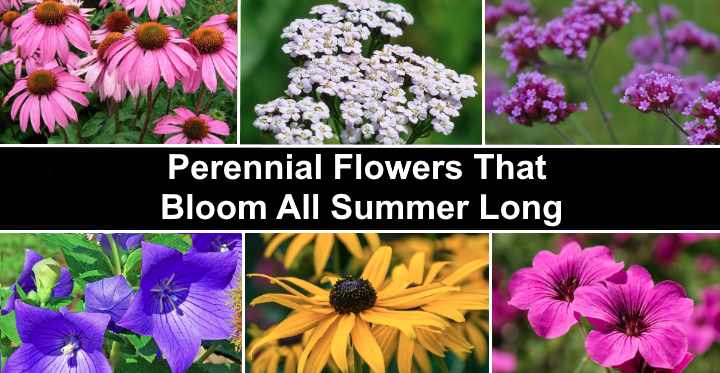
Perennials that bloom all summer are a terrific addition to any garden. Long-blooming perennial shrubs and flowers provide continuous color and beauty throughout the season. These long-lasting flowers are perfect for creating vibrant and lively landscapes. From vibrant coneflowers to tickseed, creeping phlox, and fragrant lavender, there are a variety of perennials that will bloom for several weeks, starting from late spring or early summer.
This article is a guide to choosing the best perennials that bloom throughout the summer. Descriptions and pictures of these long-blooming perennial flowers will help you select the perfect plants to keep your garden blooming from spring to fall. Additionally, you will learn helpful tips on how to care for these perennials for optimal growth and longevity.
What Are Perennial Flowers that Bloom Throughout the Summer?
Perennials are plants with a life cycle lasting for more than two years. Unlike annuals—which complete their life cycle within one year—perennials can live for multiple growing seasons. They can regrow and bloom again year after year, even after going through periods of dormancy during colder months.
Perennial flowers, shrubs, and herbs that bloom from spring to fall are excellent for low-maintenance garden landscapes. Once established, long-blooming perennials require less effort to maintain, compared to annuals, as you do not need to replant them annually.
In this list of perennial flowers that bloom throughout the summer, it’s good to remember that some flowers only grow as perennials in warmer climates. In cooler climates, the long-lasting flowers—called tender perennials—may grow as annuals because they don’t survive harsh winter conditions.
Therefore, check the growing zone before choosing a perennial to fill your front or backyard with color all through the summertime.
Perennial Flowers That Bloom All Summer Long
Please read on to learn about the best perennial flowers to plant in your garden landscape to enjoy colorful blooms throughout the summer.
Yarrow (Achillea)

Yarrow is a sun-loving perennial flowering plant providing an uninterrupted floral display from spring to fall. Blooming throughout summer, yarrow produces delicate flowers in yellow, white, pink, and red shades. The flowering clusters grow atop tall, sturdy stems and complement its fragrant feathery foliage. Yarrow plants grow 12” to 36” (30 – 90 cm).
Yarrow is a versatile, hardy perennial plant tolerating various growing conditions, including full sun, light shade, and poor, dry soil. This low-maintenance perennial is drought-tolerant once established.
Yarrow is a beautiful perennial for its pleasant fragrance, long-lasting flowers, and eye-catching flat-topped flower clusters. It’s ideal for coastal gardens, herbaceous borders, and cottage gardens.
USDA Zone: 3 to 9
Sun Exposure: Full sun to partial shade
Soil Type: Well-drained, dry to medium moisture soil
Tall Verbena (Verbena bonariensis)

Also known as purpletop verbena, tall verbena is a slender perennial that continuously blooms throughout the summer, from early summer to fall. Tall verbena adds height and pale purple or lilac colors to any garden. Its perennial flowers are clusters of small, vibrant purple star-shaped blooms on long, thin stems.
Tall verbena is easy to grow, reaching heights of 3 to 6 ft. (1 – 1.8 m) tall. It is drought and heat-tolerant and ideal for planting in southern gardens. Verbena self-seeds easily, so it returns year after year without planting it.
You can plant tall verbena in flower beds, borders, and cottage gardens to add vertical interest and a splash of color. It’s ideal for attracting butterflies and hummingbirds to gardens. In cooler climates, verbena may grow as an annual.
USDA Zone: 7 to 11
Sun Exposure: Full sun
Soil Type: Average, moist, well-drained soils
Anise Hyssop (Agastache foeniculum)

Anise hyssop is a perennial flowering plant that ensures your garden stays in bloom throughout the summer. It’s known for its tall spikes of small, tubular, purple flowers, and fragrant, licorice-scented leaves. The clump-forming perennial is ideal for adding vertical lines to your garden landscape.
Anise hyssop grows 2 to 4 ft. (0.6 – 1.2 m) tall and its lance-shaped leaves emit a pleasant anise fragrance when crushed. The attractive perennial flowers thrive from early summer to fall. Its minimal maintenance makes it a great addition to flower beds, borders, and herb gardens.
USDA Zone: 4 to 8
Sun Exposure: Full sun or partial shade
Soil Type: Average, dry to medium moisture, well-draining soils
Coneflower (Echinacea)

Coneflowers are hardy perennial flowers that bloom all summer long until the first frost. Native to North America, coneflowers are famous for their stunning purple ray flowers with a distinctive cone-shaped center and drooping petals. They typically reach a height of 1 to 4 ft. (0.3 – 1.2 m).
With their long flowering season, coneflowers are easy to grow in most soil conditions. The versatile perennials are perfect for adding height to mixed beds and borders. Thanks to their long-blooming season, hardy coneflowers will continue to bloom through the summer months. Coneflowers are tolerant of drought, heat, humidity, and deer.
USDA Zone: 3 to 10
Sun Exposure: Full sun to partial shade
Soil Type: Dry to medium soil that has excellent drainage
Black-Eyed Susan (Rudbeckia hirta)

Black-eyed Susans are ideal perennial flowers if you want to enjoy a long summer season of colorful yellow flowers. The tall yellow-flowering plants have eight to 20 bright yellow petals forming a ray around deep brown centers. These daisy-like perennial flowers bloom from early summer to frost, attracting butterflies and bees to garden landscapes.
Black-eyed Susans are full sun clumping perennials that grow 12” to 36” (30 – 90 cm) tall. Tolerant to heat, drought, and humidity, black-eyed Susans are great for adding bright colors and height to borders, flower beds, and wildflower gardens. They also make beautiful cut flowers for bouquets and arrangements.
USDA Zone: 3 to 9
Sun Exposure: Full sun
Soil Type: Most types of well-drained soil, including clay and loam
Hardy Geraniums (Cranesbill)

Hardy geraniums are tough perennial flowers that will keep your landscape colorful with constant summer blossoms. Hardy geraniums have vibrantly colored trumpet-shaped flowers consisting of five oval petals. Blooming throughout summer, the stunning flowers bloom in pink, purple, blue, white, and multicolors.
Also called cranesbills, hardy geraniums have a mounding habit and can grow between 6” and 36” (15 – 90 cm) tall. The perennials have saucer-shaped flowers, neatly cut, lobed leaves, and tolerance for growing in the toughest conditions.
Most hardy geraniums bloom in spring and last until fall. You can plant these long-flowering geraniums in borders, flower beds, rock gardens, and containers. They also make excellent ground cover plants for full sun and can help suppress weeds.
With their long blooming period and low maintenance requirements, hardy geraniums are popular with many gardeners.
USDA Zone: 4 to 8
Sun Exposure: Full sun to partial shade
Soil Type: Well-drained soil with medium moisture
Balloon Flower (Platycodon grandiflorus)

Balloon flowers are stunning perennial flowers that bloom all summer long with blue-violet flowers, although there are also cultivars available with pink blooms. These bell-shaped flowers have unique five pointed petals forming an open face. The clusters of colorful flowers create a beautiful contrast with the lance-shaped leaves that cover the stems. Balloon flowers grow 12” to 36” (30 – 90 m) tall.
Balloon flower is a reliable perennial bloomer, guaranteeing a colorful garden throughout the entire summer. They are drought-tolerant and can withstand sizzling summer temperatures. Balloon flowers are perfect for borders, cottage gardens, flower beds, and containers.
USDA Zone: 3 to 8
Sun Exposure: Full sun to partial shade
Soil Type: Light, fertile, evenly moist, well-drained soil
Bee Balm (Monarda)

Bee balm is a red-flowering sun-loving perennial with an impressive summer-long flowering cycle. Native to North America, bee balm has distinctive globular flowers with thin, wiry petals creating a fuzzy appearance. The red or purple blooms attract masses of bees, butterflies, and hummingbirds. The clump-forming perennials grow tall at 1 to 4 feet (0.3 – 1.2 m).
Bee balm is a low-maintenance, drought-tolerant perennial that withstands hot summer temperatures. You can plant the summer-blooming flowers in perennial gardens, borders, and wildflower gardens. It also performs well in containers to brighten a patio or entranceway.
USDA Zone: 3 to 9
Sun Exposure: Full sun to partial shade
Soil Type: Rich, moist soils that have good drainage
Chinese Astilbe (Astilbe chinensis)
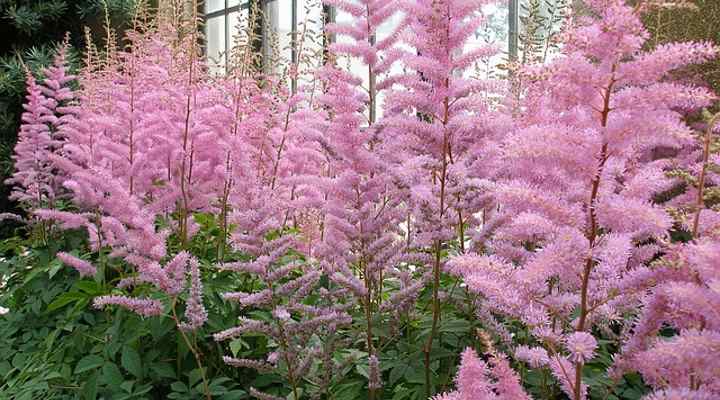
Chinese astilbe is a shade-loving perennial flower with elegant conical plumes of long-lasting flowers. Its beautiful pink, red, and white feathery plumes fill summer gardens with floral displays. Additionally, the plants have attractive fern-like foliage that turns caramel-brown in winter. Continuously blooming in summer, Chinese astilbe grows 24” to 36” (60 – 90 cm) tall.
Chinese astilbe is one the longest blooming perennials, flowering perpetually throughout the growing season in part to full shade. You can plant the popular perennial in borders or near ponds and streams. The perennials prefer partial shade and moist, well-drained soil. To ensure blooming from early spring through fall, you can plant a variety of cultivars.
USDA Zone: 3 to 9
Sun Exposure: Partial shade to deep shade
Soil Type: Continuously moist, well-drained soil
Great Blanket Flower (Gaillardia aristata)

The Great Blanket Flower is a perennial that blooms all summer long, from spring to frost. It is a hardy perennial that thrives in full sun, boasting red and yellow ray flowers. The daisy-like blooms grace the tops of long stems, while the pointed red petals sport yellow tips, creating a striking contrast with the large, serrated lance-shaped leaves. These perennial wildflowers stand erect and can grow to a height of 12” to 36” (30 – 90 cm).
Great blanket flowers attract pollinators like butterflies and bees to garden landscapes. The drought-tolerant plants create a mass of vibrant color continuously through summertime. Great blanket flowers are a beautiful landscaping choice for borders, beds, rock gardens, butterfly gardens, and container planting.
USDA Zone: 3 to 8
Sun Exposure: Full sun
Soil Type: Dry to medium well-drained soils
Tickseed (Coreopsis)

Many tickseed varieties are hardy perennial flowers with a summer-long show of colorful yellow, white, red, and pink flowers. The long-blooming, colorful daisy-like flowers cover the mounding foliage consisting of thread-like green leaves. Depending on the variety, up to 150 flowers on each mounding plant bloom throughout the summer.
Tickseed is a full sun perennial plant that grows between 12” to 24” (30 – 60 cm) tall and has fine, feathery foliage. Some smaller varieties of the flowering, spreading perennial are ideal for colorful ground cover in full sun. You can also brighten up summer gardens by planting tickseed in flower beds, borders, meadows, rock gardens, and containers.
USDA Zone: 3 to 9
Sun Exposure: Full sun
Soil Type: Poor, sand or rocky soils that are well-drained
Shasta Daisy (Leucanthemum × superbum)

Shasta daisies are perennial flowers that transform gardens with large white blooms from the summer’s start to finish. The beautiful white and yellow ray flowers face upward at the top of slender stems. This flowering herbaceous perennial has a clump-forming habit, attractive flowers, and lush, dark green foliage.
Shasta daisies grow 2 to 4 ft. (0.6 – 1.2 m) and make excellent long-lasting cut flowers. Regular watering and deadheading encourage continuous blooming throughout the entire summer. The creamy white upright flowers perform well in perennial borders, mixed beds, and cutting gardens. They are also deer-resistant and attract native pollinators like bees and butterflies.
USDA Zone: 5 to 9
Sun Exposure: Full sun to partial shade
Soil Type: Fertile, moist, well-drained soil
Pincushion Flower (Scabiosa)

Pincushion flowers are charming clump-forming perennial flowers that bloom consistently from spring to fall. The showy ruffled pincushion-shaped flower heads come in various shades of purple-lavender, pink and white. The flowerheads measure 2” (5 cm) across and bloom abundantly for extended periods. The perennial flowers measure 12” to 24” (30 – 60 cm) tall.
Pincushion flowers are easy to grow and require minimal maintenance. These purple flowers are a favorite among pollinators, attracting bees and butterflies to the garden. The long-lasting lavender flowers and gray-green foliage add beautiful color to cottage gardens, mixed borders, flower beds, and containers.
USDA Zone: 3 to 9
Sun Exposure: Full sun to light shade
Soil Type: Average, medium moisture soils that drain well
Prairie Spiderwort (Tradescantia occidentalis)

Prairie spiderwort is a native perennial wildflower that reliably produces flowers throughout the summer, from May through September. This hardy perennial has eye-catching clusters of small, three-petaled purple or bluish flowers among strap-like pointed leaves. It’s a mound-forming purple-flowering perennial that grows 12” to 24” (30 – 60 cm).
Prairie spiderwort’s lance-shaped leaves and blue-violet triangular flowers add texture and interest to any garden. The vigorous perennial has a spreading nature, making it ideal for purple-flowering ground cover in the shade. Additionally, the native wildflower performs well in borders, woodland gardens, or containers.
USDA Zone: 4 to 9
Sun Exposure: Full sun, partial shade, complete shade
Soil Type: Well-drained soil
Creeping Phlox (Phlox stolonifera)

Phlox stolonifera ‘Sherwood Purple’
With some deadheading, creeping phlox will bloom continuously all summer. This mat-forming, purple-flowering perennial has masses of star-shaped blooms growing among semi-evergreen lush foliage. The vigorous, fast-spreading plant doesn’t grow taller than 8” (20 cm) but spreads up to 2 ft. (0.6 m).
Creeping phlox is a great plant for adding color and texture to any garden landscape. The fast-spreading perennial is ideal for filling gaps in rock gardens, lining pathways, or adding color to foundation plantings. It’s also an excellent choice for a cascading container, window box, or hanging basket display.
Additionally, the purple blooms provide a beautiful contrast with other perennials growing in shaded areas.
USDA Zone: 4 to 8
Sun Exposure: Full sun, partial shade, deep shade
Soil Type: Well-drained, organically rich soil with medium moisture
Dahlias (Dahlia)

Dahlias
Dahlias are popular and versatile flowering perennials that keep your landscape lively with constant summer blossoms. Dahlias are known for their spectacular lollipop-like or pompom giant flowers. The colorful blooms fill summer gardens with lavender, dark red, pink, orange, white, yellow, and even black flowers.
Dahlias can grow 3 to 4 ft. tall (1 – 1.2 m), depending on the variety. They are often used in flower beds, borders, and containers. The showy blooms and fern-like foliage make stunning cut flowers for bouquets and arrangements.
USDA Zone: 8 to 11
Sun Exposure: Full sun to light shade
Soil Type: Most soil types if they are well-draining
Perennial Delphinium (Delphinium)
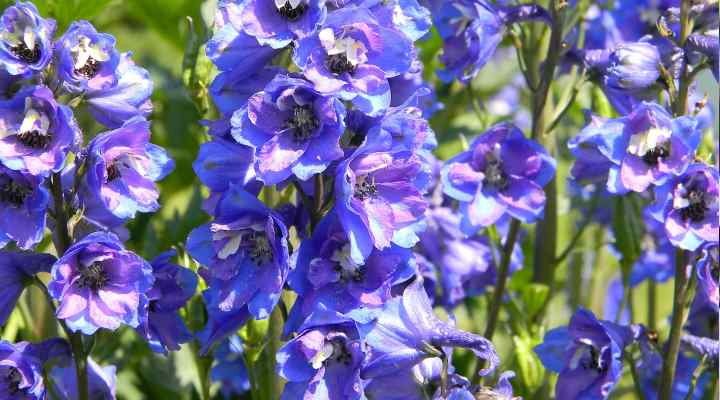
Perennial delphiniums are popular tall flowering perennials because they add vertical interest and vibrant color to gardens all summer long. They are hardy perennials with conical flowering spikes, blooming in pink, white, blue, purple, and yellow shades. The stunning ornamental flowers will bloom throughout the summer if you regularly deadhead them.
Perennial delphiniums grow 3 to 6 feet (1 – 1.8 m). Their beauty is from the long-lasting, densely packed flowers on tall spikes, creating a stunning floral display. Their vibrant colors and attractive foliage look outstanding in cottage gardens, at the back of beds, or planted along a fence line.
USDA Zone: 3 to 9
Sun Exposure: Full sun to partial shade
Soil Type: Well-drained soil
English Daisy (Bellis perennis)

English daisies are charming perennial flowers that bloom contentiously from early spring until late summer. Some varieties also bloom sporadically until frost. The small, dainty ray flowers bloom in an assortment of colors, including white, pink, burgundy, lavender and red. English daisies have a compact growth habit and grow up to 6” (15 cm) tall.
English daisies are versatile and can be used in borders, rock gardens, or naturalized areas. Some of the showiest English daisies are semi-double or double flowers resembling small dahlias. English daisies prefer cool temperatures and partial shade, making them great for spring gardens.
USDA Zone: 4 to 8
Sun Exposure: Dappled sunlight or partial shade
Soil Type: Moist, fertile, well-drained soil
Red Valerian (Centranthus ruber)

Red valerian—also known as Jupiter’s beard—is a hardy perennial plant that will fill your backyard with vibrant red colors all summer and fall. The red-flowering perennial produces dense clusters of small, star-shaped flowers in red, pink, and white shades. Blooming from early summer through fall, the masses of red flowers on tall stems attract butterflies and bees to the garden.
Red valerian grows 2 to 3 ft. (0.6 – 1 m) tall and has gray-green foliage. It is a drought-tolerant plant that is easy to grow and requires little maintenance. You can grow red valerian in borders, cottage gardens, perennial beds, and coastal landscapes.
Red valerian is also commonly used in rock gardens, containers, and patios to add a pop of deep red color.
USDA Zone: 5 to 8
Sun Exposure: Full sun to partial shade
Soil Type: Sandy, well-drained soils that have medium moisture.
Dianthus (Dianthus)

Dianthus is a group of evergreen flowering perennials with impressive summer-long showy blooms. Also called pinks or carnations, the fragrant flowers consist of ruffled petals forming eye-catching colorful rosettes. The ruffled blossoms grow at the end of erect, stout stems above the cushion of blue-green foliage.
Perennial dianthus flowers grow between 10” and 12” (25 – 30 cm) tall. The minimal-care flowers fill beds, border fronts, edgings, or containers with a profusion of color and sweet fragrances. Dianthus flowers are also popular for cut flower arrangements due to their long-lasting blooms and pleasant aromas.
USDA Zone: 5 to 9
Sun Exposure: Full sun, with some varieties withstanding partial shade
Soil Type: Neutral to alkaline well-draining soil
Queen of the Prairie (Filipendula rubra ‘Venusta’)

Queen of the prairie is a stunning perennial flower that provides an eye-catching floral showcase throughout summer. The highlight of this summer-blooming plant is its heavenly sprays of small, vibrant pink flowers. These flowers mature to pale pink, contrasting nicely with the deeply cut aromatic green leaves.
This stunning plant grows 4 to 8 feet (1.2 – 2.4 m). Blooming without letup during summer, the fluffy, pink flowers add elegance to perennial borders, mixed shrub borders, or foundation plantings. Due to its tolerance to soggy soil or boggy conditions, Queen of the prairie performs well along ponds, streams, or rain gardens.
USDA Zone: 3 to 9
Sun Exposure: Partial shade to full sun
Soil Type: Drought-intolerant, plant in soils that have consistent moisture
Columbine (Aquilegia)

Columbine is a perennial flower native to North America that provides a summer spectacle or non-fading colorful blooms. The ornamental features of columbine are its unique dangling flowers with backward-projecting spurs petals over a bell-like center and numerous stamens. Additionally, the plant has fern-like foliage.
Columbine plants grow 2” to 36” ft. (30 – 90 cm) tall. The clump-forming, nectar-rich flowers attract hummingbirds and butterflies to gardens. Long-blooming summer whimsical flowers provide plenty of color during the warmest months. Also, the shade-tolerant plant is ideal for understory planting or brightening shaded areas of your yard.
USDA Zone: 3 to 9
Sun Exposure: Full sun to partial shade
Soil Type: Organically rich, well-drained soil
Hardy Perennial Sage (Salvia)

Hardy sage is an herbaceous perennial hybrid with spectacular violet, purple, or indigo-blue summer flowers. It’s a long-lived plant that returns yearly with showy spikes of tubular flowers. The beauty of hardy sage is that the flowers bloom for weeks throughout the summer. Additionally, its foliage gives off woody aromas when crushed.
Hardy perennial sage plants are drought-tolerant and can thrive in a wide range of soil conditions. Sage plants grow 2” to 36” ft. (30 – 90 cm) tall. The flowering trouble-free herb is popular for planting in flower beds, borders, window boxes, butterfly gardens, and herb gardens.
USDA Zone: 3 to 9
Sun Exposure: Full sun
Soil Type: Sandy or gravelly soils with excellent drainage
English Lavender (Lavandula angustifolia)

English lavender is a woody, herbaceous perennial flower that blooms for several weeks starting in early summer. Famous for its fragrant blooms and aromatic foliage, lavender plants have small purple flower clusters at the tips of upright stems. This low-growing, easy-care plant grows 12” to 36” ft (30 – 90 cm) and has narrow, gray-green leaves.
English lavender is a hardy plant that thrives in full sun and well-drained soil. It is drought-tolerant and can withstand scorching summer temperatures. Landscaping uses for the colorful, fragrant blooms include herb gardens, perennial borders, rock gardens, and planters.
The fragrant flowers attract bees and butterflies, making lavender a fantastic addition to any garden or landscape.
USDA Zone: 5 to 9
Sun Exposure: Full sun
Soil Type: Poor, light, sandy soil that has excellent drainage
False Sunflowers (Heliopsis helianthoides)

Also called oxeye sunflowers, these drought-tolerant perennial flowers bloom tirelessly all summer. The attractive bright yellow, daisy-like flowers have an orange conical center with a ray of arching bright golden petals surrounding it. Blooming throughout summer to early fall, false sunflowers grow 3 to 6 feet (1 – 1.8 m) tall.
False sunflowers are low-maintenance and drought-tolerant once established. The perennials that come back year after year add a burst of vibrant colors to borders, cutting gardens, mixed beds, and containers.
To extend the blooming time, deadheading is useful for promoting new blooms.
USDA Zone: 3 to 9
Sun Exposure: Full sun to light shade
Soil Type: Reasonably fertile, consistently moist, well-draining soils
Everblooming Daylilies (Hemerocallis)

Everblooming daylilies are spectacular perennial flowers blooming continuously throughout summer. Daylily flowers typically have six petals arranged in two layers—three outer petals and three inner petals—forming an alluring cup-like structure. Some showy varieties have ruffled or fringed edges, whereas others have contrasting colors on the petal edges, throats, or midribs.
Daylily cultivars have varying bloom times, starting in March or April, and extending to late summer. Therefore, choose several varieties with different blooming times to ensure a summer-long spectacle of vibrant blooms. Daylilies are ideal for planting in shrub borders, perennial beds, or containers for a patio or balcony.
USDA Zone: 3 to 9
Sun Exposure: Full sun to partial shade
Soil Type: Moist, well-drained soils
Fairy Fan Flower (Scaevola aemula)

Fairy fan flower is a low-growing perennial that typically blooms all summer long, continuing until frost if provided with adequate light, water, and warmth. The captivating fan-shaped blooms grace the plant throughout the summer and into fall. Each flower is composed of five petals arranged in a ray formation, abundant on trailing stems. Fairy Fan Flower can reach a height of up to 18” (45 cm) and displays a spreading, trailing habit
In cooler climates, fairy fan flowers grow as heat-tolerant annuals, flourishing in full sun and well-drained soil. The plant’s trailing stems with purple or pink flowers are perfect for adding color to hanging baskets, containers, cascading over a wall, and garden borders. Fairy fan flowers bloom from spring to fall, attracting pollinators like bees and butterflies to the garden.
USDA Zone: 10 and 11
Sun Exposure: full sun or partial shade
Soil Type: Loamy soil with high organic matter and good drainage
Speedwell (Veronica longifolia)
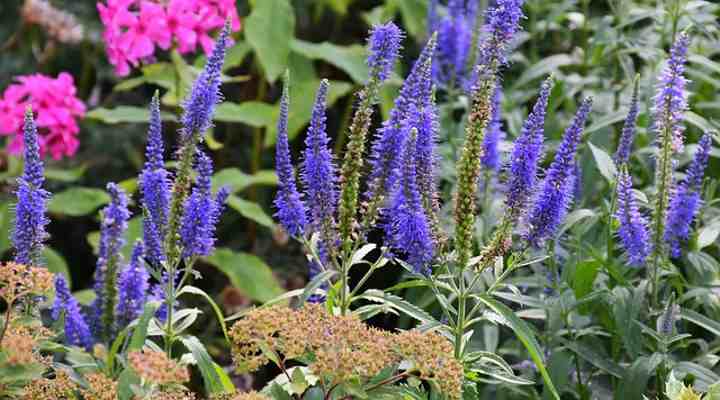
Speedwell is a long-blooming perennial with tall spikes of gracefully arching blue or purple flowers throughout the summer. Speedwell is characterized by its slender, lanceolate leaves and attractive inflorescences (flower clusters). The tall flowers add texture and height to a butterfly garden.
Speedwell blooms from early summer to early fall and grows 2 to 4 ft. (0.6 – 1.2 m) tall. This low-maintenance, deer-resistant perennial plant attracts butterflies, bees, and other pollinators. Speedwell flowers are excellent for borders, flower beds, and cottage gardens. The slender conical flowering spikes are also excellent as cut flowers.
USDA Zone: 4 to 10
Sun Exposure: Full sun to partial shade
Soil Type: Rich, moist soils that have excellent drainage
Japanese Anemone (Anemone hybrida)

Japanese anemone is an eye-catching perennial that produces attractive pastel flowers throughout the summer. The decorative flowers have silvery-pink or white petals surrounding a circle of yellow stamens. Blooming throughout summer on wiry stems and swaying in the breeze, the romantic flowers contrast nicely with deep divided green foliage.
Japanese anemone is one of the longest-blooming perennials in garden landscapes. The perennial provides weeks of color and fragrance when blooming until late fall, when many other flowers have finished blooming.
Japanese anemones prefer partial shade and well-drained soil. They grow 3 to 4 ft. (1 – 1.2 m) and spread up to 3 ft. (1 m) wide. Pink or white Japanese anemone flowers look attractive in borders, coastal landscapes, and cottage gardens to add a touch of elegance and beauty.
USDA Zone: 4 to 8
Sun Exposure: Partial shade
Soil Type: Organically rich, evenly moist, well-drained soil
Baby’s Breath (Gypsophila paniculata)
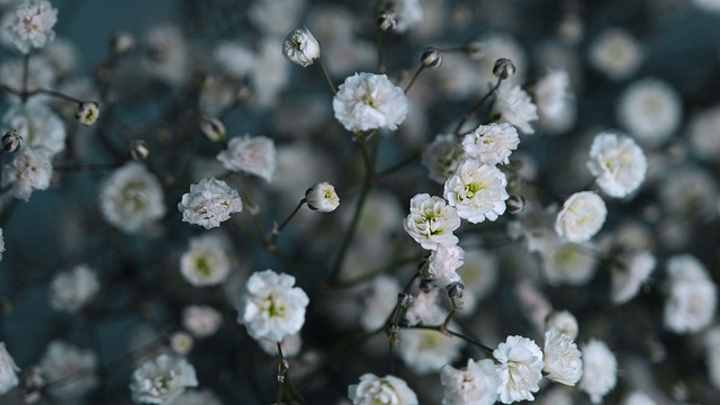
Baby’s breath is a popular white-flowering perennial flower that blooms from early summer through fall. The perennial’s endearing quality is its delicate, airy flower sprays creating billowing clouds in perennial borders. The decorative mounds of tiny flowers and small blue-green leaves grow 2 to 3 ft. (0.6 – 1 m) tall.
Baby’s breath are perennial plants that grow best in full sun, meaning at least six hours of direct sunlight on most days. In the landscape, the beautiful flowers add texture and elegance and have a softening effect on other plants. They are often used as a filler flower in bouquets and floral arrangements due to its dainty blooms and ability to add texture and volume.
USDA Zone: 3 to 9
Sun Exposure: Full sun
Soil Type: Average, dry, well-drained soils
Rose Mallow (Hibiscus moscheutos)

Rose mallow is a long blooming shrubby perennial that flowers from midsummer to early fall. Hardy hibiscus flowers are large trumpet-like blooms composed of five wide, overlapping petals, forming a dramatic, saucer-shaped flower up to 8” (20 cm) wide. The petals come in a spectrum of colors, including shades of pink, red and white, creating a dazzling display of floral splendor all summer.
Rose mallow plants grow 4 to 5 ft (1.2 – 1.5 m) tall and spread up to 6 ft. (1.8 m). They thrive in full sun and moist, well-drained soil. These hardy perennials are drought-tolerant once established and can withstand hot temperatures.
Rose mallow is a great choice for foundation plantings, mass plantings, and as a focal point in the garden wherever you want dramatic summer blooms.
USDA Zone: 4 to 9
Sun Exposure: Full sun
Soil Type: Medium to wet soils with good drainage
Butterfly Milkweed (Asclepias tuberosa)
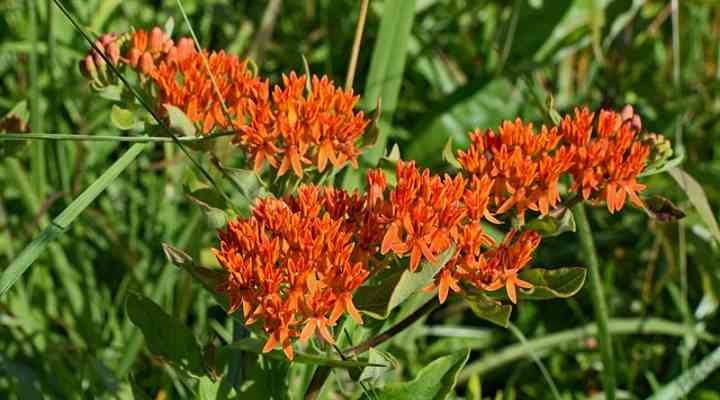
Butterfly milkweed is a bushy perennial plant with brightly colored orange flower clusters that fill summer gardens with floral delights. Native to North America, butterfly milkweed is identified by its brilliant clusters of orange star-shaped flowers and lanceolate leaves. The easy-care, drought-tolerant perennial grows 12” to 24” (30 – 60 cm) tall and wide.
Also called Indian paintbrush, this member of the milkweed family is a favorite among pollinators, particularly monarch butterflies. The drought-tolerant native wildflower thrives in well-drained soil and full sun. This perennial blooms throughout the summer from late spring, providing a long-lasting burst of color.
USDA Zone: 3 to 9
Sun Exposure: Full sun
Soil Type: Most types of well-drained soils
Beeblossom (Gaura lindheimeri ‘Whirling Butterflies’)

Beeblossom ‘Whirling Butterflies’ is a pretty perennial flower with delicate white blooms throughout the entire summer. The tough perennial is identified by its four-petalled white flowers resembling fluttering butterflies. This low-maintenance plant blooms from late spring to early fall and grows 2 to 3 ft. (0.6 – 1 m) tall.
Beeblossom has a clumping habit, helping to fill spaces in small to medium-sized yards. This versatile perennial flower is ideal for mixed borders, cottage gardens, rock gardens, and wildflower meadows. Its delicate white flowers, with their wispy stamens and wiry stems, add a touch of elegance and movement to any garden landscape.
Beeblossom is a hardy perennial that tolerates humidity, drought, heat, and arid landscapes.
USDA Zone: 5 to 9
Sun Exposure: Full sun or partial shade
Soil Type: Sandy, loamy, well-drained soils
Yellow Corydalis (Pseudofumaria lutea)

Yellow corydalis is a delicate, charming short-lived perennial flower that blooms for several weeks from late spring. These low-growing plants produce clusters of small, tubular yellow flowers 0.75” (2 cm) long. Also called rock fumewort, the small plants typically grow 12” to 15” (30 – 38 cm) tall.
Corydalis is a low-maintenance flower ideal for light shade and front-of-the-house planting. This drought-tolerant perennial is great for cottage gardens, yellow-flowering ground cover, shaded borders, and container planting. The brightly colored corydalis flowers attract butterflies and other pollinators to the garden.
USDA Zone: 4 to 9
Sun Exposure: Partial shade to full shade
Soil Type: Well-drained soil
Silver Cockscomb (Celosia argentea)

Silver cockscomb is a perennial flower in warmer zones known for its unique and striking flowers that are on show from late spring until frost. Silver cockscomb flowers are upward-pointing flowering spikes resembling a rooster’s comb, hence its name. The fascinating colorful flowers in shades of magenta, red, pink, yellow, and orange create interest in a front or backyard.
Silver cockscomb is a versatile, long-lasting perennial typically growing as an annual in cooler climates. Landscaping uses for the stunning flowering perennial include borders, cottage gardens, foundation planting, and containers. It also attracts butterflies, bees, beneficial insects, hummingbirds, and songbirds.
USDA Zone: 2 to 11
Sun Exposure: Full sun
Soil Type: Well-drained soils
Related articles:
- The Best Sun-Loving Perennials That Bloom All Summer
- Annual Flowers That Bloom All Summer Long
- The Best Perennial Flowers For Shade
